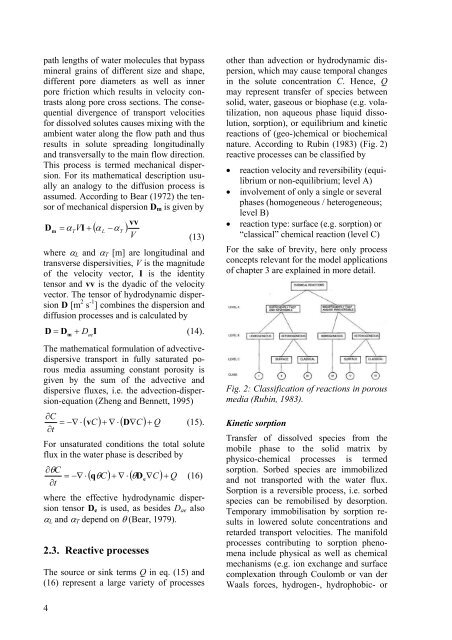Applied numerical modeling of saturated / unsaturated flow and ...
Applied numerical modeling of saturated / unsaturated flow and ...
Applied numerical modeling of saturated / unsaturated flow and ...
You also want an ePaper? Increase the reach of your titles
YUMPU automatically turns print PDFs into web optimized ePapers that Google loves.
path lengths <strong>of</strong> water molecules that bypass<br />
mineral grains <strong>of</strong> different size <strong>and</strong> shape,<br />
different pore diameters as well as inner<br />
pore friction which results in velocity contrasts<br />
along pore cross sections. The consequential<br />
divergence <strong>of</strong> transport velocities<br />
for dissolved solutes causes mixing with the<br />
ambient water along the <strong>flow</strong> path <strong>and</strong> thus<br />
results in solute spreading longitudinally<br />
<strong>and</strong> transversally to the main <strong>flow</strong> direction.<br />
This process is termed mechanical dispersion.<br />
For its mathematical description usually<br />
an analogy to the diffusion process is<br />
assumed. According to Bear (1972) the tensor<br />
<strong>of</strong> mechanical dispersion Dm is given by<br />
D m<br />
4<br />
� � I � �<br />
��L�� V<br />
TV<br />
T<br />
vv<br />
(13)<br />
where �L <strong>and</strong> �T [m] are longitudinal <strong>and</strong><br />
transverse dispersivities, V is the magnitude<br />
<strong>of</strong> the velocity vector, I is the identity<br />
tensor <strong>and</strong> vv is the dyadic <strong>of</strong> the velocity<br />
vector. The tensor <strong>of</strong> hydrodynamic dispersion<br />
D [m 2 s -1 ] combines the dispersion <strong>and</strong><br />
diffusion processes <strong>and</strong> is calculated by<br />
D m ae<br />
� D � D I<br />
(14).<br />
The mathematical formulation <strong>of</strong> advectivedispersive<br />
transport in fully <strong>saturated</strong> porous<br />
media assuming constant porosity is<br />
given by the sum <strong>of</strong> the advective <strong>and</strong><br />
dispersive fluxes, i.e. the advection-dispersion-equation<br />
(Zheng <strong>and</strong> Bennett, 1995)<br />
�C<br />
� �� � �v C�����D�C��Q<br />
(15).<br />
�t<br />
For un<strong>saturated</strong> conditions the total solute<br />
flux in the water phase is described by<br />
��C<br />
� �� � �q�C������De�C��Q(16) �t<br />
where the effective hydrodynamic disper�<br />
sion tensor De is used, as besides Dae also<br />
�L <strong>and</strong> �T depend on � (Bear, 1979).<br />
2.3. Reactive processes<br />
The source or sink terms Q in eq. (15) <strong>and</strong><br />
(16) represent a large variety <strong>of</strong> processes<br />
other than advection or hydrodynamic dispersion,<br />
which may cause temporal changes<br />
in the solute concentration C. Hence, Q<br />
may represent transfer <strong>of</strong> species between<br />
solid, water, gaseous or biophase (e.g. volatilization,<br />
non aqueous phase liquid dissolution,<br />
sorption), or equilibrium <strong>and</strong> kinetic<br />
reactions <strong>of</strong> (geo-)chemical or biochemical<br />
nature. According to Rubin (1983) (Fig. 2)<br />
reactive processes can be classified by<br />
� reaction velocity <strong>and</strong> reversibility (equilibrium<br />
or non-equilibrium; level A)<br />
� involvement <strong>of</strong> only a single or several<br />
phases (homogeneous / heterogeneous;<br />
level B)<br />
� reaction type: surface (e.g. sorption) or<br />
“classical” chemical reaction (level C)<br />
For the sake <strong>of</strong> brevity, here only process<br />
concepts relevant for the model applications<br />
<strong>of</strong> chapter 3 are explained in more detail.<br />
Fig. 2: Classification <strong>of</strong> reactions in porous<br />
media (Rubin, 1983).<br />
Kinetic sorption<br />
Transfer <strong>of</strong> dissolved species from the<br />
mobile phase to the solid matrix by<br />
physico-chemical processes is termed<br />
sorption. Sorbed species are immobilized<br />
<strong>and</strong> not transported with the water flux.<br />
Sorption is a reversible process, i.e. sorbed<br />
species can be remobilised by desorption.<br />
Temporary immobilisation by sorption results<br />
in lowered solute concentrations <strong>and</strong><br />
retarded transport velocities. The manifold<br />
processes contributing to sorption phenomena<br />
include physical as well as chemical<br />
mechanisms (e.g. ion exchange <strong>and</strong> surface<br />
complexation through Coulomb or van der<br />
Waals forces, hydrogen-, hydrophobic- or

















